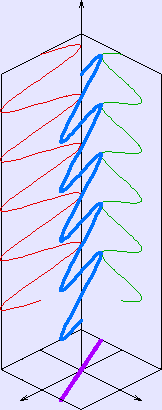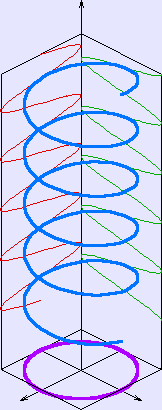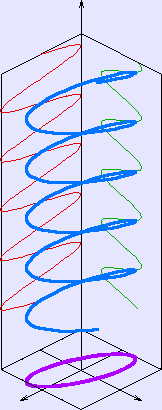.
Polarization
Polarization (Brit. polarisation) is a property of transverse waves which describes the orientation of the oscillations in the plane perpendicular to the wave's direction of travel. This concept is used in areas of science and technology dealing with wave propagation, such as optics, seismology, and telecommunications. In electrodynamics, polarization characterizes electromagnetic waves, such as light, by specifying the direction of the wave's electric field. Longitudinal waves such as sound waves in liquids and gases do not exhibit polarization, because for these waves the direction of oscillation is along (and thus is uniquely determined by) the direction of wave's travel. In contrast, the direction of the (electric field) oscillation in electromagnetic waves is not uniquely determined by the direction of propagation. Similarly, the direction of shear stress in a transverse sound wave in a solid can have any orientation in the plane that is perpendicular to the propagation direction. The term polarization thus describes the possible orientations of the oscillatory process in the plane perpendicular to the transverse wave's path.
Theory
Basics: plane waves
The simplest manifestation of polarization to visualize is that of a plane wave, which is a good approximation of most light waves (a plane wave is a wave with infinitely long and wide wavefronts). All electromagnetic waves propagating in free space or in a uniform material of infinite extent have electric and magnetic fields perpendicular to the direction of propagation. Conventionally, when considering polarization, the electric field vector is described and the magnetic field is ignored since it is perpendicular to the electric field and proportional to it. The electric field vector may be arbitrarily divided into two perpendicular components labeled x and y (with z indicating the direction of travel). For a simple harmonic wave, where the amplitude of the electric vector varies in a sinusoidal manner, the two components have exactly the same frequency. However, these components have two other defining characteristics that can differ. First, the two components may not have the same amplitude. Second, the two components may not have the same phase, that is they may not reach their maxima and minima at the same time. The shape traced out in a fixed plane by the electric vector as such a plane wave passes over it (a Lissajous figure) is a description of the polarization state. The following figures show some examples of the evolution of the electric field vector (blue) with time (the vertical axes), along with its x and y components (red/left and green/right), and the path traced by the tip of the vector in the plane (purple):



Linear , Circular, Elliptical
In the leftmost figure above, the two orthogonal (perpendicular) components are in phase. In this case the ratio of the strengths of the two components is constant, so the direction of the electric vector (the vector sum of these two components) is constant. Since the tip of the vector traces out a single line in the plane, this special case is called linear polarization. The direction of this line depends on the relative amplitudes of the two components.
In the middle figure, the two orthogonal components have exactly the same amplitude and are exactly ninety degrees out of phase. In this case one component is zero when the other component is at maximum or minimum amplitude. There are two possible phase relationships that satisfy this requirement: the x component can be ninety degrees ahead of the y component or it can be ninety degrees behind the y component. In this special case the electric vector traces out a circle in the plane, so this special case is called circular polarization. The direction the field rotates in depends on which of the two phase relationships exists. These cases are called right-hand circular polarization and left-hand circular polarization, depending on which way the electric vector rotates.
All other cases, that is where the two components are not in phase and either do not have the same amplitude and/or are not ninety degrees out of phase are called elliptical polarization because the electric vector traces out an ellipse in the plane (the polarization ellipse).
The "Cartesian" decomposition of the electric field into x and y components is, of course, arbitrary. Plane waves of any polarization can be described instead by combining waves of opposite circular polarization, for example. The Cartesian polarization decomposition is natural when dealing with reflection from surfaces, birefringent materials, or synchrotron radiation. The circularly polarized modes are a more useful basis for the study of light propagation in stereoisomers.
Retrieved from "http://en.wikipedia.org/"
All text is available under the terms of the GNU Free Documentation License

